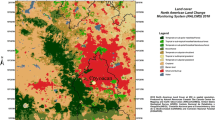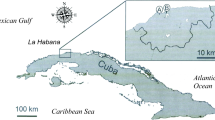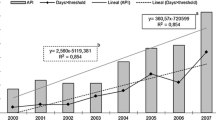Abstract
Ambrosia pollen is known as an importantallergen in North America, and more recently in someEuropean countries. From 1989 to 1995, the Ambrosia pollen levels detected at the stationsmonitored by the Aerobiological Network of Catalonia(Xarxa Aerobiològica de Catalunya, XAC) wereinsignificant. In 1996, a considerable althoughtemporary increase in the concentration of this pollenwas detected in the atmosphere over Girona, Barcelona,Bellaterra, Manresa, and Tarragona. Most of the Ambrosia pollen collected in 1996 was concentrated ina single day. Its appearance on that day wasattributed to long range transportation, caused byunusual conditions of atmospheric circulation, fromthe Lyon region in France where the species isabundant. This is the only day where concentrations ofAmbrosia pollen that may be dangerous to humanhealth have been reached.
Ambrosia coronopifolia is the most abundantspecies of the genus in Catalonia, and although rare,its expansion is favoured by the fact that it growsthrough rhizomes and sprouts easily. It is, therefore,important to monitor the growth of its population andthe release of its pollen in order to predict theappearance of pollen levels that may precipitateallergic symptoms.
Similar content being viewed by others
References
Albasser G.: 1992, Ragweed pollen sampling in Gallarate (northwest of Milan) during four years (1987-1990). Aerobiologia 8, 31-33.
Berge E.: 1988, Time-trends of sulfate and nitrate in precipitation in Norway (1972-1982). Atmospheric Environment 22, 333-338.
Bolòs, O. de and Vigo J.: 1995, Flora dels Països Catalans, vol. III. Barcelona, Barcino, pp. 769-771.
Casasayas T.: 1989, La flora al.lòctona de Catalunya. Catàleg raonat de les plantes vasculars exòtiques que creixen sense cultiu al NE de la Península Ibèrica. Phd Thesis. Barcelona, Universitat de Barcelona, pp. 132-134.
Cour P.: 1974, Nouvelles techniques de détection des flux et des retombées polliniques: étude de la sedimentation des pollens et des spores à la surface du sol. Pollen et Spores 16(1), 103-141.
Dechamp C.: 1995, L'Ambroisie. Un nouveau fléau. Limoges, Verso, 95 pp.
Dechamp C., Rimet M.L., Meon H. and Deviller P.: 1997, Parameters of ragweed pollination in the Lyon's area (France) from 14 years of pollen counts. Aerobiologia 13: 275-279.
Fernández C., Martín-Esteban M., Fiandor A., Pascual C., López-Serrano C., Martínez-Alzamora F., Díaz-Pena J.M. and Ojeda-Casas J.A.: 1993, Analysis of cross reaction between sunflower pollen and other pollens of the Compositae family. J. Allergy Clin. Immunol. 92(5), 660-667.
Goracci E. and Goracci G.: 1996, Ragweed (Ambrosia) pollen presence in Livorno, Central Italy: aerobiological and sensitization data. Aerobiologia 12, 139-140.
Hirst J.M.: 1952, An automatic volumetric spore-trap. Ann. Appl. Biol. 39, 257-265
Jäger S.: 1991, Allergenic significance of Ambrosia (Ragweed). In: G. D'Amato, F.Th. Spieksma and S. Bonini (eds), Allergenic Pollen and Pollinosis in Europe. Blackwell Scientific Publications, Cambridge, pp. 125-127.
Koch S.E., SkillmanW.C., Kocin P.J., Wetzel P.J., Brill K.F., Keyser D.A. and McCumber M.C.: 1985, Synoptic scale forecast skill and systematic errors in the MASS 2.0 model. Mon. Wea. Rev. 113, 1714-1737.
Lewis W., Vinay P. and Zenger V.: 1983, Airborne and Allergenic Pollen of North America. The John Hopkins University Press, Baltimore, pp. 139-151.
Mandrioli P., Di Cecco M. and Andina G. (1998) Ragweed pollen: The aeroallergen is spreading in Italy. Aerobiologia 14: 13-20.
Piazza G., Migliorino G.M., Cassani L. and Torret F.: 1992, Ragweed evidence in Brianza (a hilly area North of Milan). Aerobiologia 8, 27-30.
Pizzulin Sauli M.L., Larese Filon F. and Rizzi Longo L.: 1992, Ragweed presence in Trieste: clinical and aerobiological data. Aerobiologia 8, 16-20.
Pozzi P.L., Zanon P. Berra D. and Chiodini E.: 1992, Results of three years of aerobiological sampling in the atmosphere of Busto Arsizio. Aerobiologia 8, 21-22.
Prandini M., Gherson G., Zambanini G., Conci S., Salvaterra M. and Benamati G.: 1992, Pollinosis in Trentino (Northern Italy). Aerobiological and clinical research. Aerobiologia 8, 38-45.
Rogers B.L., Bond J.F., Morgenstern J.P., Counsell C.M. and Grif-fith I.J.: 1996, Immunological characterization of the major ragweed allergens Amb a I and Amb a II. In: S.S. Mohaprata and R.B. Knox (eds), Pollen Biotechnology: Gene Expression and Allergen Characterization. Chapman & Hall, New York, pp. 211-225.
Yman L.: 1982, Botanical Relations and Immunological Crossreactions in Pollen Allergy. Pharmacia Diagnostics AB, Sweden, pp. 55-57.
Author information
Authors and Affiliations
Rights and permissions
About this article
Cite this article
Belmonte, J., Vendrell, M., Roure, J.M. et al. Levels of Ambrosia pollen in the atmospheric spectra of Catalan aerobiological stations. Aerobiologia 16, 93–99 (2000). https://doi.org/10.1023/A:1007649427549
Issue Date:
DOI: https://doi.org/10.1023/A:1007649427549




